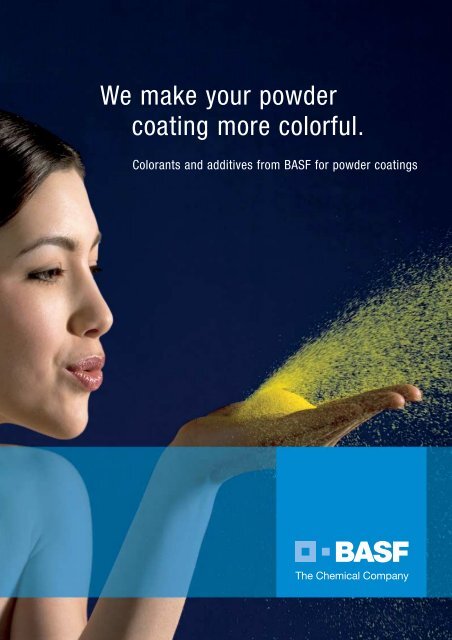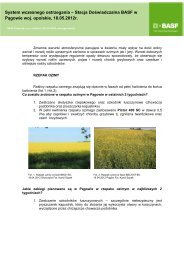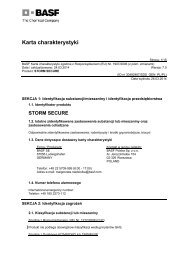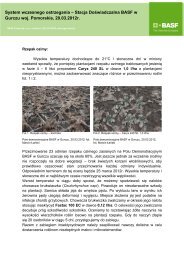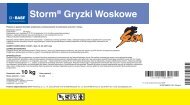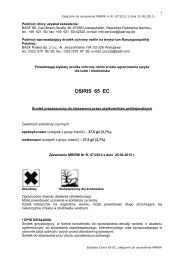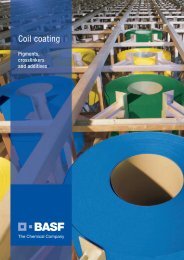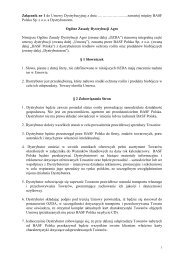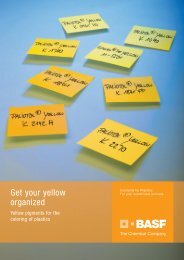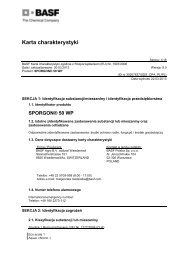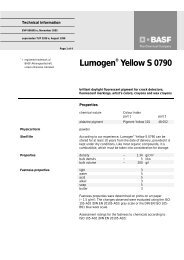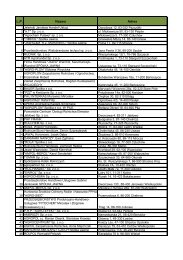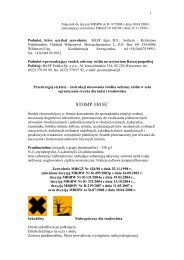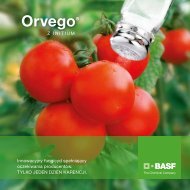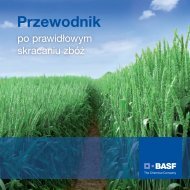We make your powder coating more colorful.
We make your powder coating more colorful.
We make your powder coating more colorful.
Create successful ePaper yourself
Turn your PDF publications into a flip-book with our unique Google optimized e-Paper software.
<strong>We</strong> <strong>make</strong> <strong>your</strong> <strong>powder</strong><br />
<strong>coating</strong> <strong>more</strong> <strong>colorful</strong>.<br />
Colorants and additives from BASF for <strong>powder</strong> <strong>coating</strong>s
<strong>We</strong> look at things as a whole –<br />
to obtain quality in the details<br />
BASF is one of the world’s leading suppliers of raw materials to<br />
the <strong>coating</strong>s industry and draws on extensive experience in<br />
developing and using raw materials for <strong>coating</strong> manufacture.<br />
<strong>We</strong> offer you a broad spectrum of pigments and dyes for <strong>powder</strong><br />
<strong>coating</strong>s, enabling you to meet the highest demands required<br />
of <strong>your</strong> products – demands for which you need advanced, ecofriendly<br />
raw materials of consistently high quality.<br />
However, from BASF you can expect a great deal <strong>more</strong> than just<br />
outstanding raw materials. The high standards we set for ourselves<br />
are apparent not only in the quality of our production, but<br />
also in our sales force and technical service.<br />
<strong>We</strong> offer you solutions based on extensive experience.<br />
Contact us – BASF is always there for you!
Contents<br />
Inorganic pigments, hybrid pigments, organic pigments 04 - 05<br />
Inorganic pigments: Sicopal ® / Sicotan ® 06 - 07<br />
Hybrid pigments: Paliotan ® 08 - 09<br />
Organic pigments: Paliotol ® / Paliogen ® / Heliogen ® 10 - 13<br />
Color Variable Pigments and effect pigments: Variocrom ® / Paliocrom ® 14 - 15<br />
Organic dyes: Neozapon ® / Thermoplast 16 - 17<br />
Additives and auxiliaries: Laropal ® / Uvinul ® / Acronal ® / Luwax ® 18 - 19<br />
Pigment selection according to various technical requirements 20 - 21<br />
Overview of pigment properties 22 - 23<br />
For <strong>powder</strong> <strong>coating</strong>s, BASF offers pigments tested for <strong>coating</strong>s<br />
applications (L grades) as well as plastics application (K grades).<br />
Experience has shown that when it comes to finely divided<br />
organic pigments, the respective K grade is often <strong>more</strong> readily<br />
dispersible and has higher color strength than the L grade of<br />
the same chemical constitution.<br />
The K grades have been especially designed with respect to the<br />
size, distribution and shape of their particles for processing<br />
conditions in the plastics industry (processing in extruders and<br />
calenders) and that these advantages also extend to the manufacture<br />
of <strong>powder</strong> <strong>coating</strong>s. From the L range we particularly<br />
recommend the HD grades (hiding and dispersibility).<br />
02 03
Know-how is part of<br />
the product range<br />
Inorganic pigments<br />
Hybrid pigments<br />
Most inorganic pigments are stable in the usual commercial<br />
<strong>powder</strong> <strong>coating</strong> resins even at elevated temperatures and are<br />
largely resistant to chemical and physical effects. They often differ<br />
from organic pigments in having a much higher hiding power<br />
and high weather resistance. The relatively low specific surface<br />
and high specific gravity of inorganic pigments have a positive<br />
influence on the rheological properties of <strong>powder</strong> <strong>coating</strong>s.<br />
BASF’s hybrid pigments are supplied under the Paliotan ® trademark,<br />
consisting of bismuth vanadate and a high-quality organic<br />
pigment. They provide an ideal combination of the advantages<br />
of inorganic (high hiding power) and organic (chroma, high color<br />
strength) pigments, while at the same time offering high cost<br />
efficiency. The most economic Paliotan ® types are based on<br />
different inorganic components.<br />
Our pigment selection takes into account the clear trend in the<br />
<strong>powder</strong> <strong>coating</strong>s industry towards raw materials that are not<br />
subject to labeling requirements and we supply only lead- and<br />
cadmium-free grades.
Organic pigments<br />
Only a range of organic color pigments can provide the maximum<br />
scope of coloristic possibilities. However, not every<br />
coloristically interesting pigment is suitable for application in<br />
<strong>powder</strong> <strong>coating</strong>s. The colorants must first satisfy a series of<br />
basic technical/physical requirements. These include heat<br />
resistance, dispersibility and good shade reproducibility.<br />
Special attention was paid to these criteria in drawing up the<br />
following pigment selection, which can <strong>make</strong> it much easier<br />
for the user to put together his final assortment. Since in practice<br />
there are a great variety of applications, each with its own<br />
requirements, we cannot consider every application possibility<br />
here. <strong>We</strong> therefore recommend appropriate preliminary tests<br />
under the user’s own specific production conditions.<br />
Examples of desirable properties:<br />
• resistance to amines and amides<br />
• hiding power<br />
• dispersibility<br />
• color strength<br />
• chromaticity<br />
• minimum plate-out<br />
• heat resistance<br />
• minimum thermochromism<br />
• suitability for over<strong>coating</strong><br />
• fastness to weathering<br />
• cost efficiency<br />
04 05
Sicopal ® / Sicotan ®<br />
Inorganic pigments<br />
Sicopal ® pigments<br />
These bismuth vanadate pigments are brilliant, greenish yellow<br />
colorants whose applications include the manufacture of leadfree,<br />
high-quality <strong>powder</strong> <strong>coating</strong>s. Special features of the<br />
Sicopal ® Yellow pigments are high purity of shade and excellent<br />
hiding power. Their resistance to weathering is outstanding both<br />
in full shades and in reductions with titanium dioxide. Sicopal ®<br />
Yellow pigments have proved to be successful substitution<br />
products for lead pigments. Shades such as RAL 1021 and RAL<br />
1028, which are difficult to achieve without using lead-based<br />
pigments, are easily obtained with Sicopal ® Yellow pigments.<br />
The standard pigment is Sicopal ® Yellow L 1100. Sicopal ® Yellow<br />
L 1120 has a slightly redder with improved chroma. It is <strong>more</strong><br />
heat-resistant in Primid ®1 crosslinked <strong>powder</strong> <strong>coating</strong>s and its<br />
hiding power and weather fastness are also outstanding.<br />
To match reddish shades we recommend the much redder<br />
alternative Sicopal ® Yellow L 1600, whose hue often allows the<br />
amount of organic shading pigments in the formulation to be<br />
reduced. The color of bismuth vanadate pigments is stable at<br />
normal baking temperatures (180 °C - 210 °C). However,<br />
severe overbaking (e.g., 60 min at 210 °C) may result in coloristic<br />
changes towards a duller, darker shade and in the formation<br />
of various surface structures (e.g., craters), depending on the<br />
resin/curing agent system used. Changes in film hardness have<br />
also been observed. Where especially good heat stability is<br />
required, we recommend suitable preliminary tests under the<br />
appropriate conditions.<br />
Sicopal ® Yellow grades are supplied exclusively as low-dusting<br />
fine granules. They are not subject to labeling requirements.<br />
Recommended for <strong>powder</strong> <strong>coating</strong> application are:<br />
Sicopal ® Yellow L 1100 P.Y. 184<br />
Sicopal ® Yellow L 1120 P.Y. 184<br />
Sicopal ® Yellow L 1600 P.Y. 184
Sicotan ® pigments<br />
The Sicotan ® Yellow grades are complex inorganic chromatic<br />
pigments. Of coloristic significance are the lemon-yellow nickel<br />
titanates (e.g., Sicotan ® Yellow L 1010) and the ocher-colored<br />
chromium titanates, for example Sicotan ® Yellow L 2110.<br />
Sicotan ® Yellow pigments are ideal for use in <strong>powder</strong> <strong>coating</strong>s.<br />
High heat stability, high hiding power and maximum fastness to<br />
weathering <strong>make</strong> them ideal for combination with organic<br />
yellow, orange and red pigments, yielding a broad spectrum of<br />
shades that meet all the requirements with respect to brilliance<br />
and high hiding power. It is often possible to use less organic<br />
pigments in formulations with Sicotan ® Yellow pigments than<br />
with titanium dioxide. This reduces the PVC (pigment volume<br />
concentration), which has a positive effect on the flow properties<br />
and also has economic benefits.<br />
Sicotan ® Yellow grades are also supplied as low-dusting, freeflowing<br />
fine granules. Such fine granules offer advantages in<br />
large-scale processing (weighing, automatic metering) and at the<br />
same time have a smaller physiological impact on personnel.<br />
Recommended <strong>powder</strong> standard grades for<br />
<strong>powder</strong> <strong>coating</strong>s:<br />
Recommended alternative fine-granules grades:<br />
Sicotan ® Yellow L 1010 P. Y. 53<br />
Sicotan ® Yellow L 1910 P. Br. 24<br />
Sicotan ® Yellow L 2010 P. Br. 24<br />
Sicotan ® Yellow L 2110 P. Br. 24<br />
Sicotan ® Yellow K 1011 FG P. Y. 53<br />
Sicotan ® Yellow K 2001 FG P. Br. 24<br />
Sicotan ® Yellow K 2011 FG P. Br. 24<br />
Sicotan ® Yellow K 2111 FG P. Br. 24<br />
06 07
Paliotan ®<br />
Hybrid pigments<br />
Paliotan ® pigments<br />
With Paliotan ® Yellow pigments, shades that were previously<br />
difficult to formulate, such as RAL 1003, 1007, 1021 und 1028,<br />
can be produced lead-free without technical difficulties. They<br />
meet requirements for hiding power, vivid color and fastness to<br />
weathering to a high degree. They can therefore be used in both<br />
industrial polyester and architectural <strong>powder</strong> <strong>coating</strong>s. Where<br />
cost efficiency is a <strong>more</strong> important consideration than fastness<br />
to weathering in formulating the <strong>coating</strong>s, choice should focus<br />
on Paliotan ® Yellow L 1135, Paliotan ® Orange L 2935 and<br />
Paliotan ® Red L 3735.
Recommended grades for <strong>powder</strong> <strong>coating</strong>s with<br />
good fastness to weathering:<br />
Grades for <strong>powder</strong> <strong>coating</strong>s whose fastness to<br />
weathering is not of primary concern:<br />
Paliotan ® Yellow L 1145<br />
Paliotan ® Yellow L 1645<br />
Paliotan ® Yellow L 1945<br />
Paliotan ® Yellow L 1135<br />
Paliotan ® Orange L 2935<br />
Paliotan ® Red L 3735<br />
Paliotan ® Yellow L 2045<br />
Paliotan ® pigments are suitable for both industrial polyester<br />
<strong>powder</strong> <strong>coating</strong>s and a large number of systems for interior use<br />
(mixed polyester or hybrids). With Primid ®1 curing agents (supplied<br />
by EMS-Chemie) we recommend performing stability tests<br />
first. The yellow and red grades should not be used in pure<br />
epoxy systems or together with matt curing agents. The heat<br />
resistance of Paliotan ® pigments is limited because of the raw<br />
materials used. If they are to be applied at temperatures significantly<br />
above 180 °C, preliminary tests should be performed in<br />
the intended application medium.<br />
08 09
Paliotol ® / Paliogen ®<br />
Organic pigments<br />
Paliotol ® pigments<br />
Paliotol ® is BASF’s trademark for organic pigments of different<br />
chemical compositions. The products described below are<br />
particularly suitable for use in <strong>powder</strong> <strong>coating</strong>s. Grades with high<br />
hiding power and good dispersibility are distinguished by the<br />
letters HD (hiding, dispersibility) following the numerical code.<br />
• Paliotol ® Yellow and Orange grades are ideal partners for the<br />
Sicopal ® and Sicotan ® Yellow pigments, because they allow<br />
the formulation of brilliant shades with good hiding power.<br />
Such combinations have often been successfully used as<br />
“lead substitution solutions”.<br />
• The Paliotol ® HD grades are particularly recommended for use<br />
in full shades. In medium and strong reductions with titanium<br />
dioxide there may be a substantial decrease in fastness to<br />
weathering. <strong>We</strong> therefore recommend minimizing the amount<br />
of titanium dioxide in the formulation and maximizing the<br />
amount of Sicotan ® Yellow (nickel or chromium titanate) or<br />
Sicopal ® Yellow (bismuth vanadate).<br />
• Paliotol ® Yellow L 0962 HD is characterized by its brilliant,<br />
greenish hue. It is ideal in combination with Sicotan ® and<br />
Sicopal ® Yellow grades. Since it has limited fastness to<br />
weathering, especially if used together with large amounts<br />
of titanium dioxide, it is not recommended for architectural<br />
<strong>coating</strong>s. Paliotol ® Yellow L 0962 HD is a pigment for full<br />
shades. Shading should be carried out with a product such<br />
as Sicopal ® Yellow L 1100/L1120.<br />
• Paliotol ® Yellow L 2140 HD is the most significant reddish<br />
yellow pigment for <strong>powder</strong> <strong>coating</strong>s. Selling points are its<br />
high hiding power and good fastness to weathering.<br />
• Paliotol ® Yellow L 2146 HD has further extended the coloristic<br />
spectrum. It is <strong>more</strong> chromatic and slightly redder in hue than<br />
Paliotol ® L 2140 HD. The application properties and fastness<br />
profile are comparable to those of Paliotol ® L 2140 HD.<br />
• Paliotol ® Yellow L 1820 is the transparent version of Paliotol ®<br />
Yellow L 2140 HD. Where high color strength is a priority in<br />
pigment selection, Paliotol ® Yellow L 1820 is the right choice.<br />
• In terms of application and coloristic properties, Paliotol ®<br />
Yellow L 1970 falls between Paliotol ® L 1820 and Paliotol ®<br />
L 2140 HD. Coloristically it comes closest to a P.Y. 83 (diaryl<br />
pigment). However, diaryl pigments are known to decompose<br />
at temperatures above 200 °C, such as may occur in polymers<br />
during processing. It has been found that temperatures above<br />
200 °C are also reached when <strong>powder</strong> <strong>coating</strong>s are being<br />
processed.<br />
• Paliotol ® Yellow L 1155 is characterized by very high color<br />
strength. To develop its full potential, it can be combined with<br />
Sicotan ® Yellow pigments. Paliotol ® Yellow L 1155 is particularly<br />
recommended for interior use. It does not cause plate-out<br />
and in full yellow shades it can also be considered for outdoor<br />
applications. Where a particularly high standard of fastness to<br />
weathering is required, preliminary tests should be carried<br />
out. On the other hand, Paliotol ® Yellow L 1155 is not suitable<br />
Recommended standard grades for <strong>powder</strong> <strong>coating</strong>s:<br />
Paliotol ® Yellow L 0962 HD P.Y. 138<br />
Paliotol ® Yellow L 1155 P.Y. 185<br />
Paliotol ® Yellow L 1820 P.Y. 139<br />
Paliotol ® Yellow L 2140 HD P.Y. 139<br />
Paliotol ® Yellow L 2146 HD P.Y. 139<br />
Paliotol ® Orange L 2930 HD P.O. 67<br />
Paliotol ® Yellow L 1970 P.Y. 139
Paliogen ® pigments<br />
as a tinting and shading pigment. It shows shade shift at<br />
temperatures above 180 °C and on overbaking.<br />
• Paliotol ® Orange L 2930 HD is a pigment with a very pure<br />
orange hue and good fastness to weathering in full shades.<br />
A formulation based on Paliotol ® L 2930 HD and Sicotan ®<br />
Yellow L 1910 (for example, for RAL 2004) is much <strong>more</strong><br />
weather-resistant than a formulation based on titanium<br />
dioxide. Paliotol ® L 2930 HD is also a pigment for full shades<br />
and therefore not suitable as a tinting and shading pigment in<br />
<strong>powder</strong> <strong>coating</strong>s. At baking temperatures above 180 °C, its<br />
suitability should first be determined in preliminary tests.<br />
None of the Paliotol ® grades we recommend is based on diaryl<br />
pigment chemistry. Diaryl pigments can decompose in polymers<br />
processed at temperatures above 200 °C.<br />
Isoindoline pigments are not suitable for use in amine- or amidecuring<br />
<strong>powder</strong> <strong>coating</strong> systems.<br />
Paliogen ® is BASF’s trademark for organic pigments of different<br />
chemical compositions and a high standard of fastness. Very high<br />
heat resistance, high hiding power and a pure hue are the outstanding<br />
features of Paliogen ® Red L 3910 HD. It can even be<br />
applied in a directly heated oven. In reductions with titanium<br />
dioxide, the fastness to weathering of Paliogen ® L 3910 HD falls<br />
significantly so that we do not recommend it for this application.<br />
• Paliogen ® Red K 4180 offers outstanding heat resistance and<br />
extremely good fastness to weathering, both in full shades and<br />
in reductions with titanium dioxide.<br />
• Paliogen ® Red L 4120 shows the same exceptional fastness<br />
properties as Paliogen ® Red K 4180 but does not attain its high<br />
standard of dispersibility.<br />
• Paliogen ® Red Violet K 5011 has distinctly <strong>more</strong> color strength<br />
and is <strong>more</strong> weather-resistant than red-violet pigments based<br />
on quinacridone. It has a high standard of heat resistance and<br />
dispersibility, but it does not offer the coloristic scope of<br />
quinacridone pigments with regard to chromaticity.<br />
• Paliogen ® Blue L 6470 has a much redder hue than Heliogen ®<br />
Blue L 6700 F. One of its uses in <strong>powder</strong> <strong>coating</strong>s is tinting<br />
white <strong>powder</strong>s. A purer white is obtained than with titanium<br />
dioxide alone. Paliogen ® Blue L 6470 has excellent fastness to<br />
weathering even at low concentrations. However, because the<br />
pigment particles are relatively hard, Heliogen ® Blue L 6700 F<br />
may in many cases be the better choice.<br />
Recommended standard grades for <strong>powder</strong> <strong>coating</strong>s:<br />
Paliogen ® Red L 3910 HD P.R. 178<br />
Paliogen ® Red L 4120 P.R. 179<br />
Paliogen ® Red Violet K 5011 P.V. 29<br />
Paliogen ® Blue L 6470 P.B. 60<br />
Paliogen ® Red K 4180 P.R. 179<br />
10 11
Heliogen ®<br />
Organic pigments<br />
Recommended grades for <strong>powder</strong> <strong>coating</strong>s:<br />
Heliogen ® Blue L 6700 F P.B. 15:6<br />
Heliogen ® Blue K 6907 P.B. 15:1<br />
Heliogen ® Blue K 6911 D P.B. 15:1<br />
Heliogen ® Blue L 7072 D P.B. 15:3<br />
Heliogen ® Blue L 7080 P.B. 15:3<br />
Heliogen ® Blue K 7090 P.B. 15:3<br />
Heliogen ® Blue L 6930 P.B. 15:1<br />
Heliogen ® pigments<br />
Heliogen ® is BASF’s trademark for copper phthalocyanine pigments.<br />
The ranges for <strong>coating</strong>s and for plastics comprise a<br />
large number of individual products, each characterized by very<br />
specific application properties. The Colour Index (C.I.) provides<br />
an initial indication for selection purposes. The following types<br />
are distinguished:<br />
• P.B. 15 copper phthalocyanine, unstable<br />
• P.B. 15:1 copper phthalocyanine, alpha stable<br />
• P.B. 15:2 copper phthalocyanine, alpha stable<br />
and surface-treated<br />
• P.B. 15:3 copper phthalocyanine, beta<br />
• P.B. 15:4 copper phthalocyanine, beta<br />
and surface-treated<br />
• P.B. 15:6 copper phthalocyanine, epsilon<br />
Extensive trials with these pigments in <strong>powder</strong> <strong>coating</strong>s have<br />
shown that the unstabilized grades are not sufficiently heatresistant<br />
and can lead to shade changes. Processing surfacetreated<br />
pigments of the type developed for conventional <strong>coating</strong><br />
systems brings no improvement, though Heliogen ® Blue L 6700 F<br />
is an exception.<br />
Both P.B. 15:1 and P.B. 15:3 have proved very satisfactory.<br />
The Colour Index alone is insufficient to assess the suitability<br />
of a pigment for <strong>powder</strong> <strong>coating</strong>s. Very significant in ensuring<br />
good dispersibility and color strength development is the surface<br />
finish of the pigment. This is applied in a process step by the<br />
manufacturer and to a considerable extent determines the<br />
specific application properties.<br />
Heliogen ® Blue pigments<br />
Heliogen ® Blue K 6907 is a new, readily dispersible, very costefficient<br />
P.B. 15:1 pigment.<br />
Heliogen ® Blue K 6911 D, because of its good dispersibility, is<br />
our special recommendation for <strong>powder</strong> <strong>coating</strong>s. Heliogen ® Blue<br />
L 6930 is comparable in coloristic and application properties<br />
to Heliogen ® Blue K 6911 D. Quality control of Heliogen ® Blue<br />
L 6930 is carried out in a conventional <strong>coating</strong> system. The<br />
special quality control (plastics test method) used for Heliogen ®<br />
Blue K 6911 D is much <strong>more</strong> like the <strong>powder</strong> <strong>coating</strong> manufacturing<br />
process than the <strong>coating</strong>s test method.
Recommended standard grades for <strong>powder</strong> <strong>coating</strong>s:<br />
Heliogen ® Green L 8730 P.G. 7<br />
Heliogen ® Green L 8731 P.G. 7<br />
Heliogen ® Green K 9360 P.G. 36<br />
Heliogen ® Green pigments<br />
Our first recommendation for a P.B. 15:3 pigment is Heliogen ®<br />
Blue K 7090, since it shows better dispersibility than most other<br />
products in the market.<br />
Heliogen ® Blue L 7072 D and Heliogen ® Blue L 7080 offer<br />
excellent performance in <strong>powder</strong> <strong>coating</strong>s. Heliogen ® Blue<br />
K 7090 is BASF’s best dispersing beta blue pigment.<br />
Despite exceptional fastness properties, even phthalocyanine<br />
blue pigments have application limits. For example, strong<br />
oxidizing agents such as 70 % nitric acid and hydrogen peroxide<br />
decolorize the colored <strong>coating</strong> and destroy the phthalocyanine<br />
blue pigment. A nitric acid test is described, for example, in US<br />
specification AAMA 2604-02, item 7.7.3.<br />
(AAMA = American Architectural Manufacturers Association)<br />
Among the phthalocyanine green pigments, a distinction is made<br />
between bluish (P.G. 7) and yellowish (P.G. 36) green types. The<br />
recommended pigments fulfill the technical requirements with<br />
respect to heat resistance, fastness to weathering and dispersibility<br />
to a very high degree.<br />
Heliogen ® Green L 8730 is the universal standard pigment for<br />
<strong>coating</strong>s. Where suitability for both <strong>powder</strong> <strong>coating</strong>s and conventional<br />
<strong>coating</strong>s is required, Heliogen ® L 8730 is the best<br />
choice. However, the best pigment for exclusive use in <strong>powder</strong><br />
<strong>coating</strong>s is Heliogen ® Green L 8731, since it was designed for<br />
this application.<br />
The high degree of halogenation of phthalocyanine green pigments<br />
<strong>make</strong>s them much <strong>more</strong> resistant to strong oxidizing<br />
agents than phthalocyanine blue pigments.<br />
12 13
Variocrom ® / Paliocrom ®<br />
Color Variable Pigments and effect pigments<br />
Variocrom ® Color Variable Pigments<br />
The Color Variable Pigments Variocrom ® Magic Gold L 1400<br />
and Variocrom ® Magic Red L 4420 consist of an SiO 2 -coated<br />
aluminum core to which an iron oxide layer has been applied<br />
by chemical vapor deposition (CVD). Variocrom ® Magic Purple<br />
L 5520 is a Color Variable Pigment based on a lamellar iron<br />
oxide. Variocrom ® Magic Green K 9811 complements the range<br />
into green.<br />
Variocrom ® Color Variable Pigments can also be used in<br />
<strong>powder</strong> <strong>coating</strong>s. They are heat-resistant and very weatherfast.<br />
Correct processing of Variocrom ® Color Variable Pigments<br />
is vital to ensure brilliant color effects in <strong>powder</strong> <strong>coating</strong>s.<br />
Due to their lamellar form, Variocrom ® Color Variable Pigments<br />
are not resistant to the effects of high shear or impact forces<br />
that may occur in extrusion or subsequent grinding.<br />
Powder <strong>coating</strong>s are best manufactured by the bonding process,<br />
which begins with the production of a conventionally colored<br />
<strong>powder</strong> <strong>coating</strong>. After extrusion and grinding, the appropriate<br />
amount of effect pigment is added. The <strong>powder</strong> is homogenized<br />
in a temperature-controlled reactor under the action of accurately<br />
defined shear forces. This process yields a homogeneous<br />
<strong>powder</strong> <strong>coating</strong> in which the effect pigment particles are tightly<br />
bonded to the <strong>powder</strong> <strong>coating</strong> particles.
Paliocrom ® effect pigments<br />
Since the effect pigment cannot separate from the <strong>powder</strong> <strong>coating</strong><br />
particles during spraying, the result is a defect-free surface.<br />
Further<strong>more</strong>, industrially processed <strong>powder</strong>s can be reused<br />
without any significant change in shade. Bonding may be carried<br />
out in suitable mixing equipment, but is also offered as a service<br />
by companies such as Benda-Lutz (Traismaur, Austria). Plant<br />
trials involving the production of large numbers of colorations<br />
have shown that application rates between 3 % and 6 % on the<br />
overall formulation result in the most interesting shades.<br />
Paliocrom ® effect pigments have a variety of physical structures,<br />
but a common feature is their flake-like morphology. Paliocrom ®<br />
Copper L 3011, Paliocrom ® Copper L 3101 (lamellar iron oxide)<br />
and Paliocrom ® Blue Silver L 6001 (mica pigment coated with<br />
reduced titanium oxides and titanium nitride) offer additional<br />
coloring and effect possibilities. Paliocrom ® Copper L 3101 is<br />
somewhat <strong>more</strong> bluish in hue than Paliocrom ® Copper L 3011<br />
and exhibits a <strong>more</strong> pronounced sparkle effect. These pigments<br />
can be combined with organic and inorganic pigments to produce<br />
further new colors and effects.<br />
14 15
Neozapon ® / Thermoplast<br />
Organic dyes<br />
Their good solubility and their fastness to light<br />
only recommend these Neozapon ® grades for<br />
<strong>powder</strong> <strong>coating</strong>s:<br />
Gelb angleichen!<br />
Neozapon ® Yellow 141<br />
Neozapon ® Yellow 157<br />
Neozapon ® Orange 251<br />
Neozapon ® Red 335<br />
Neozapon ® Red 395<br />
Neozapon ® Red 471<br />
Neozapon ® Blue 807<br />
Technical data on the dyes can be found in the<br />
product shade card Neozapon ® dyes.<br />
Organic dyes<br />
Neozapon ® dyes<br />
In contrast to pigments, dyes are soluble in the application<br />
medium. In <strong>powder</strong> <strong>coating</strong>s, the melted resin assumes the<br />
function of a solvent. Highly transparent, brilliant colorations<br />
are obtained. Application rates are typically in the 0.1 % to<br />
1 % range.<br />
The limited light fastness of Neozapon ® dyes limits their use in<br />
exterior applications. There are nonetheless a number of practical<br />
applications where Neozapon ® dyes can demonstrate their<br />
coloristic potential. For example, <strong>powder</strong> <strong>coating</strong>s are being<br />
increasingly used in the bicycle and motorcycle industry.
<strong>We</strong>ll-tried Thermoplast grades:<br />
Thermoplast Yellow 104<br />
Thermoplast Red 454<br />
Thermoplast Blue 684<br />
Technical data on these dyes can be<br />
found in the Technical Information bulletin<br />
Colorants for plastics.<br />
Thermoplast dyes<br />
Neozapon ® dyes provide some interesting styling possibilities<br />
and give rise to unusual fashion trends. Dyes can also display<br />
their transparent color effects on substrates other than metals.<br />
The difference in brilliance and transparency compared with pigments<br />
is especially apparent on glass (e.g., bottles and flacons).<br />
Thermoplast dyes are based on polycyclic compounds. Unlike<br />
metal-complex dyes, they are heavy-metal-free. Distinctive<br />
application features are their high brilliance and excellent heat<br />
resistance. However, they have limited light fastness.<br />
16 17
Laropal ® A / Uvinul ® / Acronal ® / Luwax ®<br />
Additives and auxiliaries<br />
Laropal ® A<br />
Uvinul ®<br />
Laropal ® A 81 and Laropal ® A 101 are hard resins based on<br />
isobutyraldehyde. They are used as cobinders and can be added<br />
to <strong>powder</strong> <strong>coating</strong>s to improve properties such as film hardness<br />
and pigment wetting (10 - 15 %). Addition of approx. 15 %<br />
Laropal ® A 101 (relative to the amount of binder) considerably<br />
reduces the “bronzing” of dark blue shades based on phthalocyanine<br />
blue.<br />
Uvinul ® 4050 H is a sterically hindered amine light stabilizer<br />
(HALS). Its effect in <strong>powder</strong> <strong>coating</strong>s is based on the stabilization<br />
of electric charge, especially in the application of frictional<br />
charging or tribotechnology. Uvinul ® 4050 H is incorporated with<br />
the other raw materials at an application rate of 0.3 to 0.5 %.
Acronal ®<br />
Luwax ®<br />
Acronal ® 4 F is a butyl acrylate polymer. It resists saponification<br />
and has excellent fastness to light and weathering. Acronal ® 4 F<br />
is used in <strong>powder</strong> <strong>coating</strong>s as a flow agent. The product is very<br />
viscous and cannot be incorporated directly into <strong>powder</strong> <strong>coating</strong>s<br />
as supplied. It is applied in the form of a masterbatch or precipitated<br />
on silicate.<br />
The Luwax ® grades are homopolymeric polyethylene waxes.<br />
They are supplied as <strong>powder</strong>s (A grades) and micro<strong>powder</strong>s<br />
(AF grades). Micronized polyethylene waxes are finely pulverized<br />
with a particle size in the micron range. BASF’s micronized wax<br />
<strong>powder</strong>s have a characteristic spherical shape resulting from<br />
their manufacture. Waxes can be used in <strong>powder</strong> <strong>coating</strong>s as<br />
lubricants, flow agents and release agents.<br />
They improve the scratch resistance, antiblocking properties,<br />
pourability of the <strong>powder</strong> <strong>coating</strong> mixture and flowability of the<br />
<strong>powder</strong> <strong>coating</strong> melt in the extruder. A typical application rate<br />
is 1 to 3 %.<br />
For <strong>powder</strong> <strong>coating</strong>s we recommend the<br />
following grades:<br />
Luwax ® AM 3<br />
Luwax ® AM 6<br />
Luwax ® AH 6<br />
Luwax ® AF 31<br />
18 19
Tips for selecting pigments<br />
Pigments for architectural application (good fastness to weathering):<br />
Pigments for high quality industrial <strong>powder</strong><br />
Sicopal ® Yellow L 1120<br />
Paliotan ® Yellow L 1145<br />
inorganic<br />
hybrid<br />
dioxazine (P.V. 23)<br />
iron oxide red (P.R. 101)<br />
organic<br />
inorganic<br />
Paliotol ® Yellow L 0962 HD or<br />
Paliotan ® Yellow L 1145<br />
organic<br />
hybrid<br />
Sicopal ® Yellow L 1600<br />
inorganic<br />
Heliogen ® Blue K 6911 D<br />
organic<br />
Sicotan ® Yellow L 1010<br />
inorganic<br />
Paliotan ® Yellow L 2045<br />
hybrid<br />
Heliogen ® Blue K 7090<br />
organic<br />
Sicotan ® Yellow L 1910<br />
inorganic<br />
Sicotan ® Yellow L 2110<br />
Paliogen ® Red K 4180<br />
inorganic<br />
organic<br />
Heliogen ® Green L 8731<br />
Heliogen ® Green K 9360<br />
organic<br />
organic<br />
Paliotol ® Yellow L 2140 HD or<br />
Paliotan ® Yellow L 2045<br />
organic<br />
hybrid<br />
diketo-pyrrollo pyrrol red<br />
(P.R. 254)<br />
quinacridone (P.R. 122)<br />
organic<br />
organic<br />
chromium oxide green (P.G. 17)<br />
titanium dioxide (P.W. 6)<br />
carbon black (P.Bl. 7)<br />
inorganic<br />
inorganic<br />
inorganic<br />
Paliotol ® Orange L 2930 HD<br />
Naphthol AS red (P.R. 170) or<br />
Paliotan ® Red L 3735<br />
organic<br />
organic<br />
organic<br />
quinacridone (P.V. 19)<br />
organic<br />
Sico ® Fast Scarlet L 4252<br />
organic<br />
quinacridone (P.R. 122)<br />
organic
Depending on the various technical requirements and the<br />
desired cost efficiency, BASF recommends the following<br />
pigments for different applications. Please note, however,<br />
that these recommendations should merely be regarded<br />
as a basis for discussions.<br />
Intensive discussions are indispensable in drawing up a range<br />
that meets the special requirements of a particular <strong>powder</strong><br />
<strong>coating</strong> manufacturer. For specific suggestions, please contact<br />
one of our field service representatives or sales offices. They<br />
will be pleased to offer you further assistance.<br />
<strong>coating</strong>s:<br />
Pigments for particularly economic <strong>powder</strong> <strong>coating</strong>s:<br />
quinacridone (P.V. 19)<br />
organic<br />
Paliotol ® Yellow L 1155<br />
organic<br />
Sico ® Fast Scarlet L 4252<br />
organic<br />
dioxazine (P.V. 23)<br />
organic<br />
Paliotan ® Yellow L 1135<br />
hybrid<br />
BON Red Ca Lake (P.R. 57:1)<br />
organic<br />
Heliogen ® Blue L 6700 F<br />
organic<br />
iron oxide yellow (P.Y. 42)<br />
inorganic<br />
dioxazine (P.V. 23)<br />
organic<br />
Heliogen ® Blue K 6907<br />
organic<br />
Paliotol ® Yellow L 1820<br />
organic<br />
Heliogen ® Blue K 6907<br />
organic<br />
Heliogen ® Blue K 7090<br />
organic<br />
Paliotol ® Orange L 2930 HD<br />
organic<br />
Heliogen ® Blue K 7090<br />
organic<br />
Heliogen ® Green L 8731<br />
organic<br />
Paliotan ® Orange L 2935<br />
hybrid<br />
Heliogen ® Green L 8731<br />
organic<br />
Heliogen ® Green K 9360<br />
organic<br />
iron oxide red (P.R. 101)<br />
inorganic<br />
chromium oxide green (P.G. 17)<br />
inorganic<br />
chromium oxide green (P.G. 17)<br />
inorganic<br />
Naphthol AS red (P.R. 170) or<br />
Paliotan ® Red L 3735<br />
organic<br />
inorganic<br />
titanium dioxide (P.W. 6)<br />
inorganic<br />
titanium dioxide (P.W. 6)<br />
inorganic<br />
carbon black (P.Bl. 7)<br />
inorganic<br />
carbon black (P.Bl. 7)<br />
inorganic<br />
20 21
Pigments for <strong>powder</strong> <strong>coating</strong>s<br />
Heat stability<br />
Pigment Chemical character Colour Index Density (g/cm 3 ) 20´ 180 °C 10´ 210 °C<br />
Paliotol ® Yellow L 0962 HD quinophthalone yellow P.Y. 138 2.0<br />
Sicotan ® Yellow L 1010 Ni/Sb/Ti oxide P.Y. 53 4.5<br />
Sicopal ® Yellow L 1100 bismuth vanadate P.Y. 184 6.1<br />
Sicopal ® Yellow L 1120 bismuth vanadate P.Y. 184 5.3<br />
Paliotan ® Yellow L 1135 hybrid – 3.0<br />
Paliotan ® Yellow L 1145 hybrid – 3.9<br />
Paliotol ® Yellow L 1155 isoindoline P.Y. 185 1.5<br />
Sicopal ® Yellow L 1600 bismuth vanadate P.Y. 184 5.8<br />
Paliotan ® Yellow L 1645 hybrid – 5.7<br />
Paliotol ® Yellow L 1820 isoindoline P.Y. 139 1.6<br />
Sicotan ® Yellow L 1910 Cr/Sb/Ti oxide P.Br. 24 4.4<br />
Paliotan ® Yellow L 1945 hybrid – 5.0<br />
Paliotol ® Yellow L 1970 isoindoline P.Y. 139 1.7<br />
Sicotan ® Yellow L 2010 Cr/Sb/Ti oxide P.Br. 24 4.4<br />
Paliotan ® Yellow L 2045 hybrid – 3.6<br />
Sicotan ® Yellow L 2110 Cr/Sb/Ti oxide P.Br. 24 4.3<br />
Paliotol ® Yellow L 2140 HD isoindoline P.Y. 139 1.7<br />
Paliotol ® Yellow L 2146 HD isoindoline P.Y. 139 1.7<br />
Paliotol ® Orange L 2930 HD pyrazolo-quinazolone P.O. 67 1.8<br />
Paliotan ® Orange L 2935 hybrid – 2.7<br />
Paliotan ® Red L 3735 hybrid – 1.9<br />
Paliogen ® Red L 3910 HD perylene P.R. 178 1.5<br />
Paliogen ® Red K 4180 perylene P.R. 179 1.5<br />
Paliogen ® Redviolet K 5011 perylene P.V. 29 1.6<br />
Paliogen ® Blue L 6470 indanthrone P.B. 60 1.5<br />
Heliogen ® Blue L 6700 F Cu phthalocyanine, epsilon P.B. 15:6 1.7<br />
Heliogen ® Blue K 6907 Cu phthalocyanine, alpha P.B. 15:1 1.6<br />
Heliogen ® Blue K 6911 D Cu phthalocyanine, alpha P.B. 15:1 1.6<br />
Heliogen ® Blue K 7090 Cu phthalocyanine, beta P.B. 15:3 1.6<br />
Heliogen ® Green L 8731 Cu phthalocyanine P.G. 7 2.1<br />
Heliogen ® Green K 9360 Cu phthalocyanine P.G. 36 2.1
Fastness to weathering<br />
*<br />
10´ 240 °C Dispersibility Full shade Reduction Hiding power Tinting strength Resistance to amine/amide<br />
4 - 5 3 low fair fair<br />
5 5 fair low high<br />
5 5 high low high<br />
5 5 high low high<br />
– 4 - 5 3 high fair low<br />
4 - 5 4 high fair fair<br />
– – – low high low<br />
5 5 high low high<br />
4 - 5 4 high fair low<br />
– – – low high low<br />
5 5 high low high<br />
4 - 5 4 high fair low<br />
4 - 5 3 fair high low<br />
5 5 high low high<br />
4 - 5 4 high fair low<br />
5 5 high low high<br />
4 - 5 3 - 4 fair fair low<br />
4 - 5 3 - 4 fair fair low<br />
– 4 2 fair fair low<br />
– 4 2 high fair low<br />
– 4 2 high fair high<br />
4 - 5 2 high fair high<br />
5 5 fair high high<br />
4 - 5 4 - 5 low high high<br />
4 - 5 4 - 5 low high high<br />
4 - 5 4 - 5 low high high<br />
4 - 5 4 - 5 low high high<br />
4 - 5 4 - 5 low high high<br />
4 - 5 4 - 5 low high high<br />
4 - 5 4 - 5 low high high<br />
4 - 5 4 - 5 low high high<br />
Assessed as total color yE < 2<br />
difference DE with reference 2< yE < 4<br />
to 20´ 160 °C 4< yE < 6<br />
– yE> 6<br />
very easily dispersible<br />
easily dispersible<br />
not easily dispersible<br />
*<br />
Titanium dioxide reduction ratio for<br />
inorganic pigments 1:1<br />
organic pigments 1:10<br />
22 23
Contact worldwide<br />
Asia<br />
BASF (Malaysia) Sd. Bhd.<br />
2, Jalan U8/87<br />
Seksyen U8, Bukit Jelutong<br />
40706 Shah Alam, Selangor Darul Ehsan<br />
Malaysia<br />
Tel.: + 60 3 728 3813<br />
Fax: + 60 3 747 6781<br />
Europe<br />
BASF Aktiengesellschaft<br />
Performance Chemicals for<br />
Coatings, Plastics and Specialties<br />
E-EVP/EM - J 550<br />
67056 Ludwigshafen<br />
Germany<br />
Tel.: + 49 621 60-72907<br />
Fax: + 49 621 60-58320<br />
Eastern Europe, Africa, <strong>We</strong>st Asia<br />
BASF Aktiengesellschaft<br />
Regional Business Management<br />
Performance Chemicals<br />
EUM/SE - Benckiserplatz 1<br />
67056 Ludwigshafen<br />
Germany<br />
Tel.: + 49 621 60-76429<br />
Fax: + 49 621 60-6676429<br />
South America<br />
BASF S.A.<br />
Estrada Samuel Aizemberg<br />
1707-Bloco C-3°<br />
09851-550 São Bernardo do Campo - SP<br />
Brazil<br />
Tel.: + 55 11 4343-3680<br />
Fax: + 55 11 4343-3134<br />
North America<br />
BASF Corporation<br />
1609 Biddle Avenue<br />
Wyandotte, MI 48192<br />
USA<br />
Tel.: + 1-734-324-6760<br />
Fax: + 1-734-324-5185<br />
The data contained in this publication are based on our current knowledge and experience. In view of<br />
the many factors that may affect processing and application of our product, these data do not relieve<br />
processors from carrying out their own investigations and tests; neither do these data imply any guarantee<br />
of certain properties, nor the suitability of the product for a specific purpose. Any descriptions,<br />
drawings, photographs, data, proportions, weights etc. given herein may change without prior information<br />
and do not constitute the agreed contractual quality of the product. It is the responsibility of the<br />
recipient of our products to ensure that any proprietary rights and existing laws and legislation are<br />
observed. When handling these products, advice and information given in the safety data sheet must be<br />
complied with. Further, protective and workplace hygiene measures adequate for handling chemicals<br />
must be observed.<br />
® = registered trademark of BASF Aktiengesellschaft<br />
®1 = registered trademark of EMS-Chemie Holding AG<br />
TM = trademark of BASF Aktiengesellschaft<br />
www.basf.com/pigment<br />
BASF Aktiengesellschaft<br />
Performance Chemicals for<br />
Coatings, Plastics and Specialties<br />
67056 Ludwigshafen<br />
Germany<br />
EVP 1105 e


